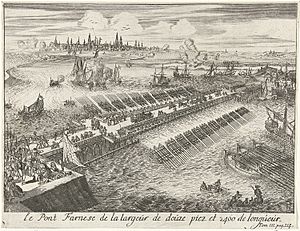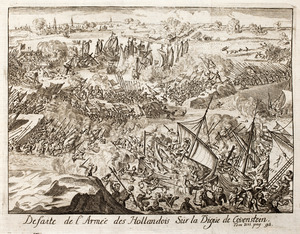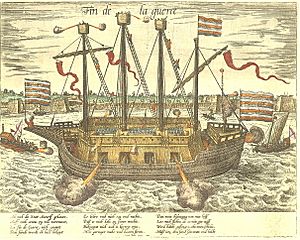Fall of Antwerp facts for kids
Quick facts for kids Fall of Antwerp |
|||||||
|---|---|---|---|---|---|---|---|
| Part of the Eighty Years' War | |||||||
 Parma's bridge over the Scheldt in 1585, built of ships. |
|||||||
|
|||||||
| Belligerents | |||||||
| Commanders and leaders | |||||||
| Strength | |||||||
| 80,000 men (inhabitants) |
10,000 infantrymen, 1,700 cavalrymen | ||||||
| Casualties and losses | |||||||
| 8,000 | ~1,800 | ||||||
The Fall of Antwerp happened on August 17, 1585. This event was part of the Eighty Years' War. The city of Antwerp was under siege for over a year, from July 1584.
Antwerp was a very important city for the Dutch Revolt. This revolt was led by Protestants against Habsburg Spain. After a long siege, the city had to give up to the Spanish army.
As part of the surrender, all Protestants in Antwerp were given four years to leave. Many of them moved north to cities like Amsterdam. Amsterdam then became a major city in the Dutch Republic.
Antwerp lost many of its traders and its trade suffered for a long time. Dutch forts blocked the River Scheldt, which was important for trade. This blockade lasted until 1795.
Contents
Why Antwerp Was Important
At this time, Antwerp was in what is now Belgium. It was the biggest city in the Habsburg Netherlands. It was also a major center for culture, money, and business in Europe.
In 1576, Spanish soldiers who had not been paid attacked Antwerp. This event was called the Spanish Fury. Thousands of people were killed and many homes were burned.
Because of this attack, Antwerp became even more involved in the fight against Spanish rule. The city joined the Union of Utrecht in 1579. This union was a group of Dutch provinces that rebelled. Antwerp became the main city for the Dutch Revolt.
Philip II of Spain then focused on the rebellion in the Low Countries. In 1577, he sent Prince Alessandro Farnese with more soldiers. Farnese's job was to help Spain get back control.
By the time the siege of Antwerp began in 1584, Farnese had already taken back many areas. His army had grown stronger. At the start of the siege, he had about 10,000 foot soldiers and 1,700 horsemen.
The Siege of Antwerp Begins
Farnese improved how his army got supplies. He used the "Spanish Road," which was a main route from Italy to the Low Countries. This road had forts to protect supplies.
When the siege started, Farnese's army had plenty of supplies. First, they surrounded Antwerp. They built forts along the Scheldt river. This helped them stop trade with other cities.
The goal was to control the river and prevent supplies from reaching Antwerp. However, Fort Lillo was not captured. So, Farnese had to find another way to block the river. He decided to build a huge bridge across the Scheldt.
Building Farnese's Bridge
Since Fort Lillo could not be taken, Farnese built his bridge upstream. He chose a spot where the river had two sharp bends. Two new forts were built: Saint-Mary on one side and Saint-Philip on the other. The bridge connected these two forts.
The bridge was made of strong tree trunks driven into the riverbed. These trunks were connected by heavy wooden beams and chains. This made the structure very strong. A pathway of planks was laid on top, forming the bridge. It had walls on both sides to protect soldiers.
In the middle of the river, where it was too deep for piles, Farnese used 32 large boats. These boats were chained together side-by-side. Each boat had two cannons. This floating section connected the two parts of the bridge.
The entire bridge was about 2,400 feet long. It was finished on February 25, 1585. This bridge completely blocked the Scheldt river.
Giambelli's "Infernal Machines"
To fight the bridge, the Dutch flooded the land next to the Scheldt. This made many roads disappear under water. Spanish forts became isolated on small islands.
The Dutch tried to use small boats with cannons to control the river. But the Spanish forts were well-armed and held their ground.
The Dutch also tried to send "fire ships" to destroy the bridge. The most famous were Federigo Giambelli's "infernal machines." These were two ships filled with gunpowder and heavy objects like gravestones and scrap metal. They were designed to explode.
On April 4, 1585, the ships were launched. One ship exploded far from the bridge. The other hit the bridge on the Flemish side and blew up. The explosion was massive. It sent water over the dikes and threw stones almost a mile away.
About 800 Spanish soldiers were killed, including Caspar de Robles. The Dutch did not follow up with a relief mission, thinking the damage was not enough. Farnese quickly repaired the bridge.
The Battle of Kouwenstein
The rebels still did not give up. Their next plan was to break the Kouwenstein dike. This would let relief ships from Holland and Zeeland reach Antwerp.
The Kouwenstein dike was a low, narrow bank about three miles long. It had deep water on both sides. Farnese knew this dike was important and had it guarded.
On May 26, the Antwerpian fleet, led by Marnix Saint-Aldegonde, and the Holland-Zeeland fleet, led by Count Hohenlohe, attacked the dike.
The rebels took control of parts of the dike and started breaking it. They made an opening big enough for a ship to pass through. Marnix and Hohenlohe were on this ship.
Farnese rushed to the battle. He saw how serious the situation was and quickly acted. He brought in cannons and soldiers. Seven hours after the attack began, he turned the battle around.
The ocean's tide shifted, causing many rebel ships to get stuck. The Holland-Zeeland ships drifted away, leaving the Antwerpians alone. Nearly half of the 4,000 rebel soldiers died. This defeat ended any real resistance from the rebels.
The "End of War" Ship
After the battle, Farnese saw a huge ship among the Antwerpian fleet. This was a floating fortress meant to attack the Spanish forts and the bridge. It had four masts and 20 large cannons. Its hull was covered in cork to make it unsinkable.
This ship was another invention by Giambelli, called the Finis Belli ("End of War"). The Antwerpians had high hopes for it. However, the ship was too big and hard to control. It was an expensive failure.
The capture of the "End of War" ship made the people of Antwerp lose hope. They felt there was no way to defeat Farnese. The Dutch finally gave up, seeing Antwerp as a lost cause.
Antwerp Surrenders
With the city cut off and supplies running low, people started to suffer from hunger. The Catholics in the city strongly demanded that talks with Farnese begin.
These talks were led by Marnix. On August 17, he signed the surrender of Antwerp.
After the siege, the Dutch fleet stayed on the Scheldt river. They kept blocking the city's access to the sea. This cut Antwerp off from international trade.
Farnese placed experienced Spanish soldiers in Antwerp to make sure the city stayed under Spanish control. Farnese's demands were fair, and his troops behaved well. This was surprising given the bloody siege and the earlier "Spanish Fury." Farnese gave strict orders not to loot the city.
Antwerp's Protestant population was given four years to leave. Some became Catholic again, but many moved north. This ended a very successful time for Antwerp.
Before the siege, Antwerp had 100,000 people. Afterward, only 40,000 remained. Many skilled workers moved north. This helped build the wealth of the northern United Provinces during the "Dutch Golden Age."
Even though Antwerp became prosperous again, the Dutch continued to block trade on the Scheldt river. This stopped the city from regaining its former glory. The blockade lasted for two centuries. It was a very important and difficult part of the history between the Netherlands and what would become Belgium.
See also
 In Spanish: Sitio de Amberes (1584-1585) para niños
In Spanish: Sitio de Amberes (1584-1585) para niños




